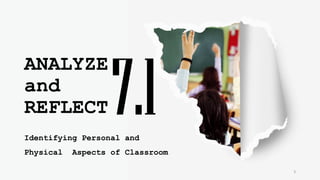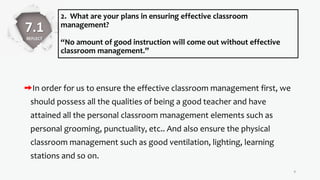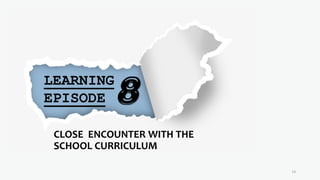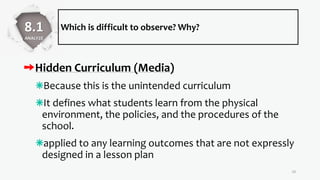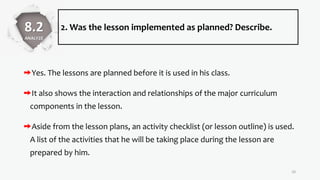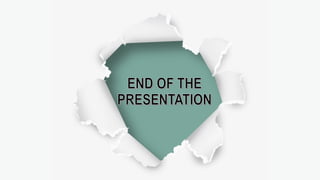FS1-EP07-EP08-2021.pdf
- 1. FIELD STUDY 1 LEARNING EPISODE 7 & 8 GROUP III
- 2. PHYSICAL AND PERSONAL ASPECTS OF CLASSROOM MANAGEMENT 2
- 3. ANALYZE and REFLECT Identifying Personal and Physical Aspects of Classroom 3
- 4. 1. How does the voice of the teacher affect classroom instruction? The voice is a very important asset for the teacher. If used well the voice can capture the students attention and initiate involvement with the teacher and subject matter. A moderate loud and a clear/good voice of a teacher is one of the most important elements of personal classroom management. In terms of classroom instructions, the voice of the teacher should be clear and loud enough to be heard in the entire classroom so that all the learners must pay attention and listen attentively during class discussion. Also, a teacher must speak an authoritative way in order for him/her to be respected by the learners. 4 7.1 ANALYZE
- 5. 1. How does the voice of the teacher affect classroom instruction? It forces the student to quiet down in order to hear what you’re saying. Instead of embarrassing a student by yelling or correcting behavior in front of the whole class, show respect by whispering a firm reminder. Speaking to them with a direct and sincere tone of voice will help them build trust and meet your expectations. A dull monotonous voice will only serve to bore the students and dull the desire to pay attention and participate. 5 7.1 ANALYZE
- 6. 2. How does the punctuality of the teacher affect classroom discipline? The punctuality and the behavior of the teacher reflects to the learners because if the learners could see that their teacher is punctual then they will also try their best to follow the behavior of the teacher. But if the teachers is always late and shows laziness in the classroom, then it will negatively affect the classroom discipline and management. 6 7.1 ANALYZE
- 7. 3. Why do we need to check on the physical aspects of classroom management? We need to check on the physical aspects of the classroom management in order for both the teacher and the learners to have a smooth flow of discussion and learning activities. Having the best of these physical classroom elements in the learning environment would ensure the safety and order in the class. 7 7.1 ANALYZE
- 8. 1. What does this statement mean to you as a future teacher? Explain. “No amount of good instruction will come out without effective classroom management.” 8 7.1 REFLECT If a teacher in a certain classroom doesn't know how to effectively manage a classroom, then he/she will also not be able to formulate and give any good instruction that sometimes leads to the failure of the students to learn.
- 9. 2. What are your plans in ensuring effective classroom management? “No amount of good instruction will come out without effective classroom management.” In order for us to ensure the effective classroom management first, we should possess all the qualities of being a good teacher and have attained all the personal classroom management elements such as personal grooming, punctuality, etc.. And also ensure the physical classroom management such as good ventilation, lighting, learning stations and so on. 9 7.1 REFLECT
- 10. ANALYZE and REFLECT Demonstrating knowledge of positive and non-violent discipline in the management of learner behavior. 10
- 11. 1. How many strategies were employed by the Resource Teacher? Did these contribute to better classroom management? Explain your answer. There are many strategies employed by the Resource Teacher and these strategies indeed contributed to better classroom management. Because according to our Resource Teacher if you yourself as a teacher plays as the role model to your students and you show respect and authority to the class eventually you will achieve the effective implementation of these classroom management strategies. 11 7.2 ANALYZE
- 12. 2. What were not used by the resource teacher? Were these important? What should have been used instead? Explain. As we interview our Resource Teacher, he have said that these classroom management are somehow the same with what he implemented in his class and he added that these are all important and effective and were all been used. 12 7.2 ANALYZE
- 13. 1. What classroom management strategies do I need to employ to respond diverse types of learners? The classroom management strategies that we need to employ in order to respond to diverse types of learners are first, interview them to assess their needs and let them work in groups in order for them to be aware of their individual differences. Consider peer teaching and take time to celebrate group effort. These are just some of the many important classroom management strategies tp effectively employ in the class and as we go on, we can always think of new strategies and improvement in our classroom. 13 7.2 REFLECT
- 14. CLOSE ENCOUNTER WITH THE SCHOOL CURRICULUM 14
- 15. ANALYZE and REFLECT Curricula in the School Setting 15
- 16. Which of the 7 types of curriculum in the school setting is easy to find? Why? Which is difficult to observe? Why? Are these all found in the school setting? How do curricula relate to one another? Draw a diagram to show the relationship of one curriculum to the other. 16 8.1 ANALYZE
- 17. Which of the 7 types of curriculum in the school setting is easy to find? Why? Recommended Curriculum (K – 12 Guidelines) recommended by scholars and professional organizations Basic Education (by DepEd); Higher Education (by CHED); Vocational Education (by TESDA) Written Curriculum Documents based on recommended curriculum syllabi, course of study, module, books, instructional guides, lesson plan 17 8.1 ANALYZE
- 18. Which of the 7 types of curriculum in the school setting is easy to find? Why? 18 8.1 ANALYZE Taught Curriculum Teaching Learning Process Teachers actually deliver day by day Assessed Curriculum appears as tests and measures performance state tests, standardized tests, district tests, and teacher-made tests Learned Curriculum Achieved Learning Outcomes bottom-line curriculum it is the curriculum that students actually learn
- 19. Which is difficult to observe? Why? Hidden Curriculum (Media) Because this is the unintended curriculum It defines what students learn from the physical environment, the policies, and the procedures of the school. applied to any learning outcomes that are not expressly designed in a lesson plan 19 8.1 ANALYZE
- 20. Are these all found in the school setting? How do curricula relate to one another? Yes. The relationship between curricula to one another is highly connected and they both serve to enhance each other. For instance, curriculum is the foundation of education and the curriculum is what makes the education quality stand out. from a basic level to increasingly complex topics or skills. 20 8.1 ANALYZE
- 21. Draw a diagram to show the relationship of one curriculum to the other. 21 8.1 ANALYZE
- 22. Relationship of the Different Curriculums 2 3 2 6 7 1 4 3 5 Recommended Curriculum Written Curriculum Taught Curriculum Supported Curriculum Assessed Curriculum Learned Curriculum Hidden Curriculum TYPES OF CURRICULUMS
- 23. Make a reflection on the diagram that you have drawn. The relationship between the different types of curriculum is highly connected and they both serve to enhance each other. Curriculum is one of many tools used to give you an education or a method you use to do the teaching. Some curriculums work better than others, and/or better for certain students more than others. 23 8.1 REFLECT
- 24. ANALYZE and REFLECT The minuscule School Curriculum: The Lesson, A Closer Look 24
- 25. 1. How does the teacher whom you observed compare to the ideal characteristics or competencies of global quality teachers? He facilitate and inspire student learning and creativity so that all students achieve in the global society. He work with their students to co-create new learning opportunities. He uses data to support student learning and program improvements. He said that “learning about and with the world occurs within and outside of school, and it is the work of a lifetime”. 25 8.2 ANALYZE
- 26. 2. Was the lesson implemented as planned? Describe. Yes. The lessons are planned before it is used in his class. It also shows the interaction and relationships of the major curriculum components in the lesson. Aside from the lesson plans, an activity checklist (or lesson outline) is used. A list of the activities that he will be taking place during the lesson are prepared by him. 26 8.2 ANALYZE
- 27. 3. Can you describe the disposition of the teacher after the lesson was taught? Happy and eager satisfied and contented? Disappointed and exhausted? It shows that the teacher is happy and satisfied. Because he knew himself that he delivered the lesson according to planned and the studetns also actively participating in the class. He demonstrated the professional attitudes and conduct that facilitate student learning and convey a positive image of the education profession. 27 8.2 ANALYZE
- 28. Based on you observations and tasks in Activity 2, how will you prepare your lesson plan? Make a short paragraph on the topic. Regardless of the parts of a lesson plan, each lesson it should build on the prior lesson and flawlessly flow into the next. Alongside from the major components of a curriculum, there are some guidelines to follow. Each one has some important aspects that go into its construction such as the type/level of students, their prior knowledge which will allows us to continue with the flow, and the teaching techniques that you we can use in your lesson plan. Afterwards are the identifying og the learning objectives, planning specific learning activities, organize the lesson, and assess students’ learning. 28 8.2 REFLECT
- 29. ANALYZE and REFLECT Constructive Alignment of the Components of a Lesson Plan 29
- 30. 1. Are the three components constructively aligned? Explain. Yes, the three components are constructively aligned from setting the learning outcomes, down to what methods to be accurately use to achieve the outcomes and what type of assessment to be conducted to test the level of learning the student has. For example, in TLE. The Teacher set an outcome for student to be able to cook a French Omelette. The teaching method she used was to let the student watch the video. And she assess the student through cooking activity. 30 8.3 ANALYZE
- 31. 2. Will the outcomes be achieved with the teaching methods used? Why? Yes, the outcomes was achieved with the teaching methods the teacher used. Although, it was modular but then the teacher provided an illustration of the steps in cooking French Omelette and link for the video for those who can avail to watch. Basically, we think the outcome has achieved through this teaching method. 31 8.3 ANALYZE
- 32. 3. What component would tell if the outcomes have been achieved? The Evaluation and Assessment part will tell if the outcomes have been achieved when the students able to get a passing or above average scores and perform well the activity set. 32 8.3 ANALYZE
- 33. What lessons have you learned in developing or writing a lesson plan? The lessons we have learned in developing or writing a lesson plan is that you need to align the three components so you could achieve what you want to achieved. You need to plan a head the knowledge, skills and values you want to achieve by your students, choose the right method to achieve the desired outcome and it is a must to provide evaluation and assessment that is anchored with your learning outcomes to test where your learner's at the time of learning. 33 8.3 REFLECT
- 34. What value will it give to the teacher if the three components are aligned? The value of success will be gained by teacher if the three components are aligned together. Success in delivering the lessons efficiently, and learning to the students effectively. 34 8.3 REFLECT



